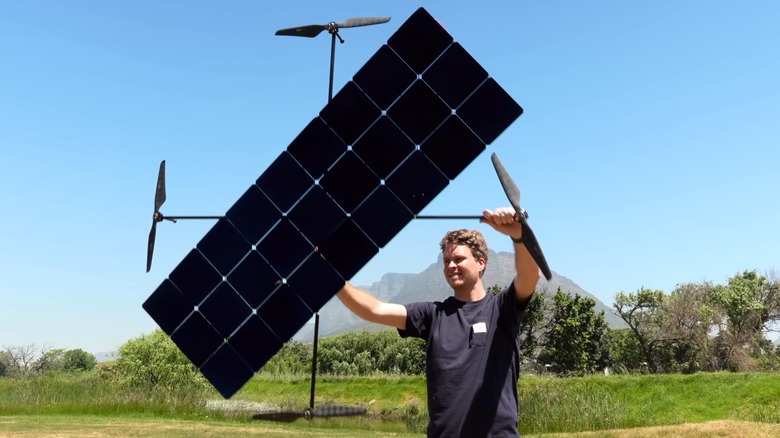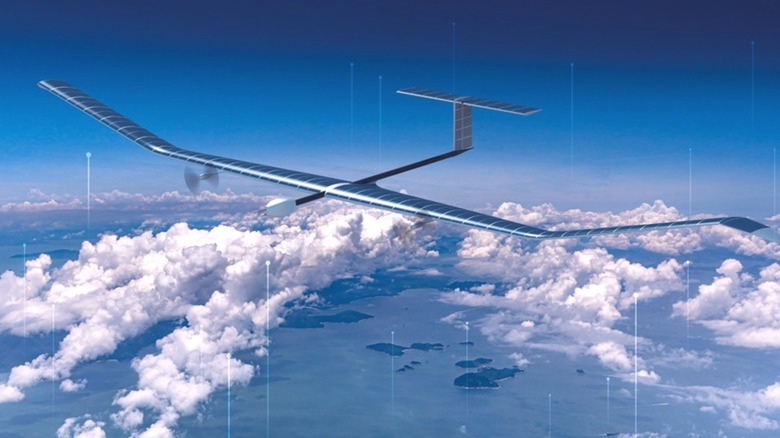This Homemade Drone Can Theoretically Fly Forever
Drones are pretty much ubiquitous these days, and there are so many types, it's truly remarkable. One niche in the drone market involves long-runtime drones, which appeal to all sorts of industries, be they military or commercial. Putting a drone into the sky and not having to worry about landing or refueling it in any way offers an ability most drones lack. Even the biggest and most technologically advanced military drones like the RQ-4 Global Hawk cannot stay airborne forever.
Regardless, plenty of people are working hard to make ultra-long-runtime drones a reality, including Mike and Luke Bell, the inventors of the world's fastest quadcopter. The father-son duo has created a multi-rotor aircraft that has no battery and is instead powered by a large array of solar panels. Theoretically, it could fly forever... or so long as it flies with the sun on its back. The interesting thing about this drone isn't its solar-powered nature; it's the lack of batteries.
Typically, solar energy is collected and stored in some kind of battery for use when there's no direct sunlight overhead. Batteries are heavy, and the Bells wanted to create something different that wasn't hindered by the extra weight. They ended up building a 100% solar-powered-drone that flies, making it more of a proof-of-concept project than something with commercial applications. That's impressive for hobbyists who work as aerial videographers and photographers. Further innovations could see somewhat similar devices take to the skies in the future.
The Bells' 100% Solar-Powered-Drone
The Bells approached the project knowing they didn't want to include batteries in the design, which made construction of the drone itself relatively easy. They constructed an X-frame from carbon fiber tubing, ensuring it was as light as possible. They used lightweight Antigravity motors fitted with T-Motor 18-inch carbon fiber propellers. Other parts were 3D-printed, including the mounts. They added a small camera to feed POV video to a VR headset.
They connected 27 fragile solar panels — several broke during testing, and one fell victim to the family cat. The panels are arranged in three rows of nine, and when connected, they supply an output of around 150 watts. The panels themselves were mounted onto a secondary support structure made of 3 mm carbon fiber tubing, which was bolted to the drone's X-frame. Once it was all put together, the Bells drove to a field and tested it. They posted a build video with the flight test footage on YouTube, and the drone lifted off the ground and flew just as they planned.
It did have a somewhat hard landing but survived the drop onto the grassy field. The panels directly supplied the motors with energy, and all four powered evenly, allowing for level flight. The test kept the aircraft relatively close to the ground, and while there's little hope of commercial applications for such a drone, it's nonetheless a brilliant engineering achievement, proving batteries aren't required. Of course, for the military, it wouldn't be an option.
High-flying, long-endurance solar-powered drones are a goal for the military
Military drones can stay in the air for a long time. Still, they're limited to, at most, 40 hours for some models. They're used primarily for airborne intelligence, surveillance, and reconnaissance (ISR). Keeping them aloft for as long as possible would improve collection capabilities across the board. The Airbus Zephyr (pictured) High Altitude Platform Station (HAPS) is a fully electric aircraft that can fly for months at a time at altitudes exceeding 60,000 feet, putting it above weather and air traffic.
This is ideal because, while satellites collect intelligence, they're limited in some areas. Putting a persistent aircraft at high altitude overcomes several factors in ISR collection, so a lot of time and money is being invested in creating fully electric, solar-powered drones. Granted, they don't omit batteries, as this would eliminate their ability to operate when the sun isn't shining, but aircraft like the Zephyr are still similar to the Bells' solar-powered quadcopter.
HAPS aren't restricted to military use, as they also have commercial applications, so it's likely future examples will be more diversified. One capability is functioning as an airborne tower, extending Internet or cell service to remote locations. The Zephyr's connectivity payload has a coverage area of nearly 2,900 square miles, so the applications for these kinds of drones are considerable. That's what makes the Bells' drone so incredible — they didn't spend hundreds of millions to create what companies like Airbus have made for much more.


